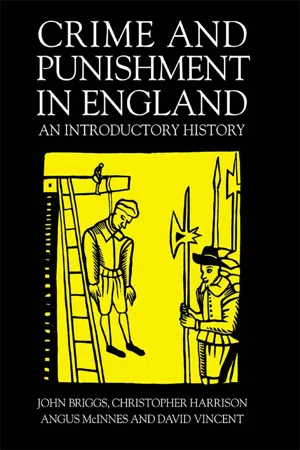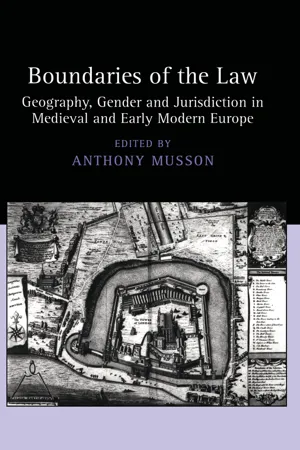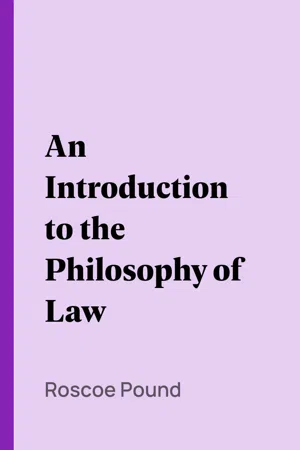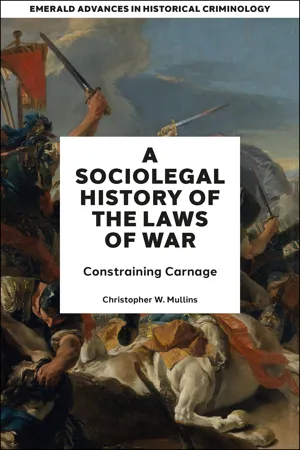History
Medieval Law and Order
Medieval law and order in Europe was characterized by a system of feudalism, where local lords held authority over their territories and administered justice. The legal system was based on customary law, with trials often decided by ordeal or combat. The church also played a significant role in legal matters, particularly in cases involving moral or religious offenses.
Written by Perlego with AI-assistance
Related key terms
5 Key excerpts on "Medieval Law and Order"
- eBook - ePub
Crime And Punishment In England
An Introductory History
- John Briggs, Christopher Harrison, Angus McInnes, David Vincent(Authors)
- 2005(Publication Date)
- Routledge(Publisher)
For most people most of the time, the courts that most impinged on their lives were the local manor courts. These were held by the local lord or more usually his steward. In it the peasants could and did sue each other, transfer bond land and make by-laws for the running of the common fields. Peasants could be and were charged, tried by local juries and convicted of such criminal offences as affray and theft. In other words, the court had a criminal as well as a civil jurisdiction. By the thirteenth century, punishments were restricted to fines or amercements, although in the pre- and post-Conquest period they also had the right in some cases to hang offenders. Court records were maintained from the late thirteenth century. In many cases, although they were the most junior of the courts, these were the most important for most people. It is significant that these courts administered a mixture of private and public justice, that is they made their own laws but also enforced the king’s.Conclusion
On a practical level, the medieval period bequeathed to the English criminal justice system the following elements:The law, as a body of authoritative knowledge, had arrived. What did these developments mean? For the first time since the collapse of Roman civilization there was a body of authoritative knowledge exclusive of the Church. The Church’s monopoly on learning was ended. Secondly, the development of rules of law provided an objective check on arbitrary action by rulers and other great lords. The law became a control over royal and seigneurial power. Secular authority was no longer absolute. Thirdly, the law by its self-definition helped, in a sense, to define the state; for good or ill, it created the state.- (a) the King’s Bench—the settled Westminster court to hear important criminal cases;
- (b)royal justice taken into the counties through the eyre system;
- (c) the county and the hundred as the basic units of administration of criminal justice;
- (d) the sheriff, albeit increasingly circumscribed and controlled, as county peace-keeping officer;
- (e) juries of presentment, later to become the grand juries;
- (f) trial juries;
- (g) coroners and coroner’s juries for investigating violent death;
- (h) justices of the peace, by which landed gentry were given a central role in the county criminal justice system.
- eBook - ePub
Boundaries of the Law
Geography, Gender and Jurisdiction in Medieval and Early Modern Europe
- Anthony Musson, Anthony Musson(Authors)
- 2017(Publication Date)
- Routledge(Publisher)
2 However, it is also clear that this symbolic universality of royal justice was subject to a series of cultural and logistical compromises that help us in turn to 'map' the relative application of royal justice in different parts of the realm.Several of the practical considerations that we might identify as limiting the effective reach of the king's law during the later Middle Ages relate to the changes brought about in the structure and personnel of the royal courts during the fourteenth and fifteenth centuries. The thirteenth-century state had followed a general policy of centralisation, operating through the emergent courts of King's Bench and Common Pleas and sending out centrally-supervised commissioners 'in eyre' to make periodic visitations of the shires and assume control over all cases pending in the local public courts.3 But the sheer weight of business generated especially by lesser criminal actions, coupled with the political compromises implicit in the new 'war state' of the late thirteenth and fourteenth centuries, had the effect of devolving responsibility for the operation of the law into the hands of local elites, through the development of the office of justice of the peace.4 The commissions of the peace, staffed mainly by the gentry resident in the relevant counties, represented a viable response – perhaps the only viable response – to the challenge of providing a permanent judicial presence for the crown in the localities. At first, the state sought to regulate the justices of the peace by requiring that members of the Westminster-based judiciary be present at sessions in which trespasses and/or felonies were brought to trial and judgment.5 But by the end of the fourteenth century such regulations had already been relaxed and the relationship between the central and local agencies of royal justice became more complex and subtle, relying as much on traditions of honour and service among the peace commissions themselves as it did on any structured process of direction from Westminster.6 - eBook - ePub
- Roscoe Pound(Author)
- 2010(Publication Date)
- Perlego(Publisher)
status quo. This conception answered to the needs of medieval society, in which men had found relief from anarchy and violence in relations of service and protection and a social organization which classified men in terms of such relations and required them to be held to their functions as so determined. Where the Greeks thought of a stationary society corrected from time to time with reference to its nature or ideal, the Middle Ages thought of a stationary society resting upon authority and determined by custom or tradition. To each, law was a system of precepts existing to maintain this stationary society as it was.In the feudal social order reciprocal duties involved in relations established by tradition and taken to rest on authority were the significant legal institutions. With the gradual disintegration of this order and the growing importance of the individual in a society engaged in discovery, colonization and trade, to secure the claims of individuals to assert themselves freely in the new fields of human activity which were opening on every side became a more pressing social want than to maintain the social institutions by which the system of reciprocal duties was enforced and the relations involving those duties were preserved. Men did not so much desire that others perform for them the duties owing in some relation, as that others keep hands off while they achieved what they might for themselves in a world that continually afforded new opportunities to the active and the daring. The demand was no longer that men be kept in their appointed grooves. Friction and waste were apprehended, not from men getting out of these grooves, but from attempts to hold them there by means devised to meet the needs of a different social order whereby they were made to chafe under arbitrary restraint and their powers were not utilized in the discovery and exploitation of the resources of nature, to which human powers were to be devoted in the succeeding centuries. Accordingly the end of law comes to be conceived as a making possible of the maximum of individual free self-assertion.Transition to the newer way of thinking may be seen in the Spanish jurist-theologians of the sixteenth century. Their juristic theory was one of natural limits of activity in the relations of individuals with each other, that is, of limits to human action which expressed the rational ideal of man as a moral creature and were imposed upon men by reason. This theory differs significantly from the idea of antiquity, although it goes by the old name. The Greeks thought of a system of limiting men's activities in order that each might be kept in the place for which he was best fitted by nature—the place in which he might realize an ideal form of his capacities—and thus to preserve the social order as it stands or as it shall stand after a rearrangement. The sixteenth-century jurists of the Counter-Reformation held that men's activities were naturally limited, and hence that positive law might and should limit them in the interest of other men's activities, because all men have freedom of will and ability to direct themselves to conscious ends. Where Aristotle thought of inequalities arising from the different worth of individual men and their different capacities for the things which the social order called for, these jurists thought of a natural (i.e., ideal) equality, involved in the like freedom of will and the like power of conscious employment of one's faculties inherent in all men. Hence law did not exist to maintain the social status quo - eBook - ePub
A Socio-Legal History of the Laws of War
Constraining Carnage
- Christopher W. Mullins(Author)
- 2023(Publication Date)
- Emerald Publishing Limited(Publisher)
In the tenth and eleventh centuries, we begin to see more systematic codification of laws in post-Charlemagne Europe and especially in the attempt of Henry II of England to forge a “common law” for the British Isles. Ultimately, the Church lost the overall struggle for legal control over Europe and the jurisdiction of Canon law declines through the centuries, eclipsed by local, secular law. Chivalry envisions an international brotherhood of knights, bound by specific obligations and possessing specific rights, separate from the political loyalties and boundaries of the day. This chapter starts by examining early legal codes that emerged in the wake of the Roman Empire's collapse (i.e., Salic law, the Visogothic code), at least those aspects that dealt with military matters. It will then look at the Church's attempt to curb violence with the Pax and Treuga and how these efforts evolve into the normative and literary system of chivalry. It provides a thorough discussion of the cultural aspects of chivalry and examines chivalric manuals written to promote and teach these ideals. Post-Roman Europe In the wake of the Roman Empire, what would become Europe was divided, localized, and save for settlements where direct control could be exerted, anarchic. The third–fifth centuries ce were no stranger to warfare, it was such a common occurrence that whether peace or war was the natural state of humanity was a central theological debate (Augustine, 1950, 1958, 1961). Unfortunately, we lack the written and archaeological evidence to accurately estimate the amount of inter-group violence occurring. Most peoples of the period had enforceable normative codes, whether codified or not - eBook - ePub
- Peter Linehan, Janet L. Nelson, Marios Costambeys, Peter Linehan, Janet L. Nelson, Marios Costambeys(Authors)
- 2018(Publication Date)
- Routledge(Publisher)
The whole subject cries out for more comparisons, not only between different jurisdictions and countries in Europe, but also with other continents – preferably without the teleological assumptions of growing rationality and European superiority that Max Weber made academically respectable (Reynolds 2013). At the same time as law became more professional it changed in ways – different ways in different places – that were probably less connected with each other than tends to be assumed when they are lumped together in a supposed progress towards ever greater rationality. The different kinds of change need to be investigated. That professional law became more systematic in its reasoning is clear. Whether this means it became altogether more rational in a wider sense is harder to say. Ordeals were abandoned but torture was developed, while the trials of animals that look so ludicrous to modern eyes seem to have been a feature of learned law as much as, or more than, it was of simple rustic practices (Cohen 1986). But if it is too simple to see medieval law as progressing to rationality, it is also too simple to see it regressing from happy harmony. Without taking refuge under an equally simplistic functionalism, it seems reasonable to conclude that the new system was an integral part of the new government: both surely resulted from much wider social and economic changes. People at the bottom of society came off badly under both systems, but both reflected and partly embodied aspirations to justice.Notes
1The chapter on Anglo-Saxon law in Pollock and Maitland is by Pollock but Township and Borough and Domesday Book and Beyond show Maitland’s work on that period. The Collected Papers and his introductions to various Selden Society volumes also contain many insights into later medieval law.2Some exceptions: Dawson 1960 and 1968; Berman 1983; for other work by American scholars comparing English and French government and law, see Reynolds 1997b at n. 27. The series of Comparative Studies in Continental and Anglo-American Legal History, which started with Coing and Nörr 1985, includes some volumes on the Middle Ages (e.g. vol. 5 (Baker 1989) and vols. 6–7, ed. C. Donahue, on records of church courts).3Donahue 1986 provides a survey on canon law.4I refer generally to ‘academic lawyers’ rather than ‘jurists’, because ‘jurists’ can be ambiguous when used to translate Fr. juristes or It. giuristi, since these words are used of professional as well as academic lawyers.5Bastardas 1991, cc. 29–33, 123, and pp. 9, 170 (c. 88); Valls Taberner 1984, c. 168, and p. 66.6Colección de Documentos 4: nos. 40, 67, 71, 88, 98, 99, 113, 114, 145, 146, 147; Liber Feudorum Maior
Index pages curate the most relevant extracts from our library of academic textbooks. They’ve been created using an in-house natural language model (NLM), each adding context and meaning to key research topics.




